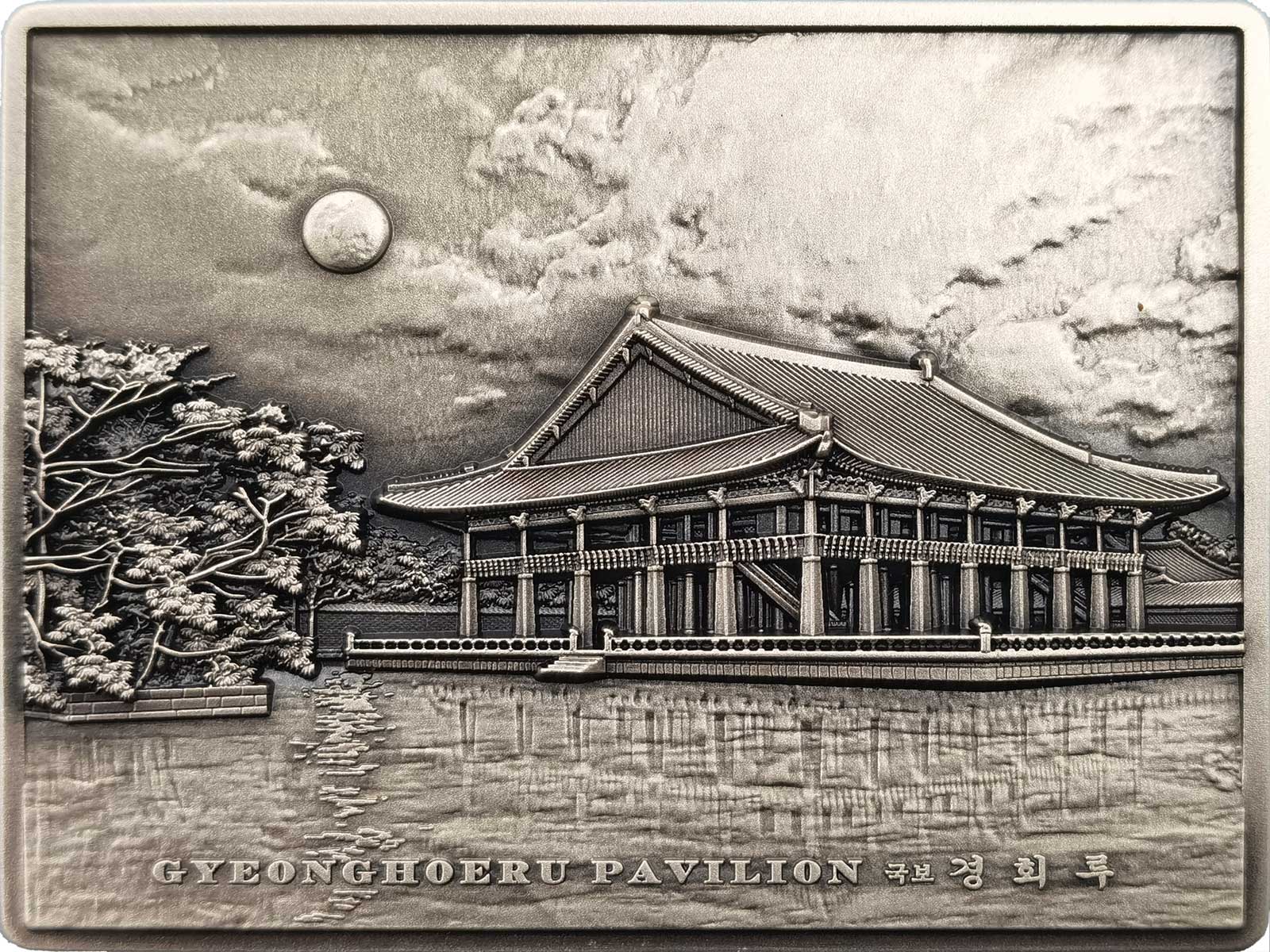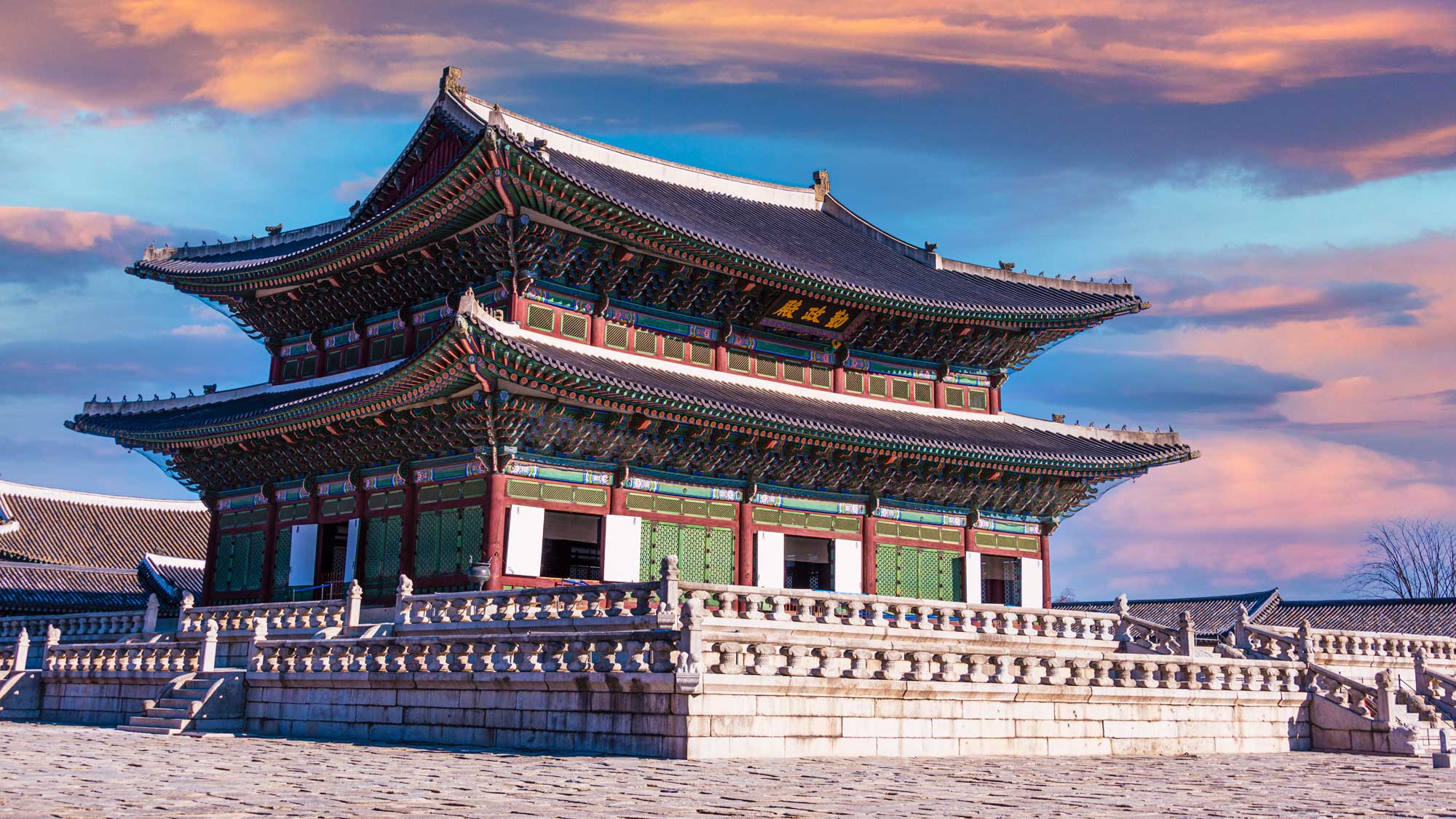Gyeongbokgung, the Korean royal palace of the Joseon Dynasty, adorns a series of five-ounce silver coins
New from Coins Today in Korea, is the third in their series of five-ounce silver coins showcasing one of Korea’s most iconic locations, the Gyeongbokgung Palace Complex in Seoul. The series will systematically take a look at some of the striking structures that sit on this historical site, even though most have been rebuilt after extensive damage in the early 20th century.
Each showcases a particular building, and in the case of this latest release, it’s the Hyandwonjeon Pavilion. These are very nice coins, depicting classic Korean architecture. Each is rectangular (60 x 48 mm), antique-finished, and struck to a high-relief. Mintages are very low, with the first two issues topping out at 333, and the latest just 222 pieces. Unfortunately, the third issue is the first to be made available outside of Korea, so tracking down the first two may be a little more difficult.
The producer has given us lots of background information on the various buildings, which we’ve reproduced below, along with some images of the structures as they are today. Each coin comes boxed with a Certificate of Authenticity. A neat look at a culture that’s never been more popular than it is now.
GYEONGBOKGUNG
Gyeongbokgung, also known as Gyeongbokgung Palace or Gyeongbok Palace, was the main royal palace of the Joseon dynasty. Built in 1395, it is located in northern Seoul, South Korea. The largest of the Five Grand Palaces built by the Joseon dynasty, Gyeongbokgung served as the home of Kings of the Joseon dynasty, the Kings’ households, as well as the government of Joseon.
Gyeongbokgung continued to serve as the main palace of the Joseon dynasty until the premises were destroyed by fire during the Imjin War (1592–1598) and abandoned for two centuries. However, in the 19th century, all of the palace’s 7,700 rooms were later restored under the leadership of Prince Regent Heungseon during the reign of King Gojong. Some 500 buildings were restored on a site of over 40 hectares. The architectural principles of ancient Korea were incorporated into the tradition and appearance of the Joseon royal court.
In the early 20th century, much of the palace was systematically destroyed by Imperial Japan. On January 21, 1963, it was designated as a cultural property. Since the 1990s, the walled palace complex is gradually being restored to its original form. Today, the palace is arguably regarded as being the most beautiful and grandest of all five palaces. It also houses the National Palace Museum and the National Folk Museum within the premises of the complex.
ISSUE III: HYANDWONJEON PAVILION
HYANGWONJEONG is a small, hexagonal, two-story pavilion found in the grounds of Gyeongbokgung. The pavilion was built on the orders of King Gojong around 1873, and it is thought to have acted as a place of leisure and relaxation for the Joseon Dynasty kings and their family members.
Following excavation work carried out in 2019, it was found that Hyangwonjeong had the traditional Korean system of heated floors called ondol. Pavilions of this period were often equipped with ondol heating systems, but what makes Hyangwonjeong unique is how the smoke travelled along the sides of the first floor, instead of going through the middle.
The pavilion was constructed on an artificial island in the centre of a lake called Hyangwonji. The lake is home to many large, beautifully coloured carp and in season lots of lotus flowers. A bridge, Chwihyanggyo, connects the island and the pavilion to the rest of the palace grounds. Hyangwonjeong can be translated as “pavilion of far-reaching fragrance,” while Chwihyanggyo translates as “bridge intoxicated with fragrance.”
Chwihyanggyo was originally located on the north side of the island, and was the longest bridge constructed purely of wood during the Joseon dynasty. Unfortunately, the bridge was destroyed during the Korean War. The bridge was reconstructed in its present form on the south side of the island in 1953, but was relocated to its original location on the north side during reconstruction work completed in 2019.
ISSUE II: GYEONGHOERU PAVILION
GYEONGHOERU was erected in the northwest side of the pond in Geunjeongjeon, Gyeongbokgung Palace, and was used to hold the royal banquets and receiving foreign officials. Gyeonghoeru was built when the construction of Gyeongbokgung Palace was first made, and was small at first but was expanded in 1412 (the 12th year of King Taejong of Joseon) as the pond was enlarged. It was burnt down during the Japanese Invasion in 1592, leaving only the stone supports.
It was reconstructed about 270 years later when it was rebuilt in 1867 (the 4th year of King Gojong of Joseon) while rebuilding Gyeongbokgung Palace. After building a square island with long and smooth stone, the pavilion was built on them. It was connected with the land by three stone bridges to the grand Gyeonghoeru Pavilion.
Behind the pavilion, a hill called Amisan, made up of the soils from digging up the earth in the pond, was erected. Gyeonghoeru that has 7 rooms in the front and 5 rooms in the side is a two-story of splendid and magnificent building. During the reign of King Taejong, there were 48 stone pillars, carved with wriggling dragon. Under the reconstruction, square pillars were erected outside, while circular pillars were erected inside. The first floor was covered with a square stone, while the second floor was covered with wooden floor.
The height of the room floor was different so that officials could sit according to respective position. The roofs were made up of a set of decorative roof tiles over the angle rafter which is the fine point of the palace. As the largest elevated pavilion in Korea, the simple and yet splendidly designed pavilion is considered as a valuable cultural asset, representing the work style of the late Joseon Dynasty.
ISSUE I: GEUNJEONGJEON HALL
GYEONGHOERU was erected in the northwest side of the pond in Geunjeongjeon, Gyeongbokgung Palace, and was used to hold the royal banquets and receiving foreign officials. Gyeonghoeru was built when the construction of Gyeongbokgung Palace was first made, and was small at first but was expanded in 1412 (the 12th year of King Taejong of Joseon) as the pond was enlarged. It was burnt down during the Japanese Invasion in 1592, leaving only the stone supports.
It was reconstructed about 270 years later when it was rebuilt in 1867 (the 4th year of King Gojong of Joseon) while rebuilding Gyeongbokgung Palace. After building a square island with long and smooth stone, the pavilion was built on them. It was connected with the land by three stone bridges to the grand Gyeonghoeru Pavilion.
Behind the pavilion, a hill called Amisan, made up of the soils from digging up the earth in the pond, was erected. Gyeonghoeru that has 7 rooms in the front and 5 rooms in the side is a two-story of splendid and magnificent building. During the reign of King Taejong, there were 48 stone pillars, carved with wriggling dragon. Under the reconstruction, square pillars were erected outside, while circular pillars were erected inside. The first floor was covered with a square stone, while the second floor was covered with wooden floor.
The height of the room floor was different so that officials could sit according to respective position. The roofs were made up of a set of decorative roof tiles over the angle rafter which is the fine point of the palace. As the largest elevated pavilion in Korea, the simple and yet splendidly designed pavilion is considered as a valuable cultural asset, representing the work style of the late Joseon Dynasty.
COMMON OBVERSE
| SPECIFICATION | |
| DENOMINATION | $5 Fiji |
| COMPOSITION | 0.999 silver |
| WEIGHT | 155.5 grams |
| DIMENSIONS | 60.0 X 48.0 mm |
| FINISH | Antique |
| MODIFICATIONS | High-relief |
| MINTAGE | 222 (333 for Issue I and II) |
| BOX / C.O.A. | Yes / Yes |









Leave A Comment